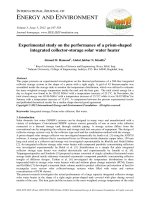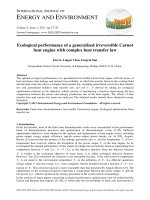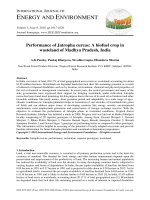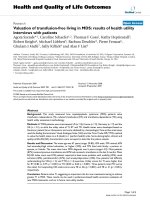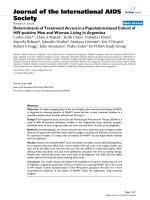Mitigation performance of household living in disaster prone II of MT.Slamet
Bạn đang xem bản rút gọn của tài liệu. Xem và tải ngay bản đầy đủ của tài liệu tại đây (463.57 KB, 10 trang )
MITIGATION PERFORMANCE OF HOUSEHOLD LIVING IN
DISASTER PRONE II OF MT.SLAMET
Diah Setyawati Dewanti1
Assoc. Prof. Dusadee Ayuwat*2
Prof. Sekson Yongvanit3
1
Department of Development Economics, Faculty of Economics and Business,
Universitas Muhammadiyah Yogyakarta, Indonesia
2
Department of Sociology and Anthropology, Faculty of Humanities and Social Sciences,
Khon Kaen University, Khon Kaen, Thailand
3
Department of Development Science, Faculty of Humanities and Social Sciences,
Khon Kaen University, Khon Kaen, Thailand
*corresponding author
Abstract
This study has an aim to study the mitigation performance of household living in
disaster prone II of Mt. Slamet. Living harmony with disaster is employed by Indonesia. To
gain the research objective, this study use sequential mixed methodology supported by
qualitative research and quantitative research sequentially. It was started with indepth
interview to 29 key informants for qualitative and 538 households as the samples for
quantitative approach. Variables are consist of mitigation, household characteristics,
capitals of households and transformation on process and structure. The study area is
located in the disaster prone II, approximately 4-6 km from the peak of Mt.Slamet, which
had households work in agriculture and tourism sector. Mitigation phase describe the
household warning system and the evolvement of disaster management. The result of this
study explained household characteristics for number of healthy hosehold member
(0.101*), owning the size of land (-0.118*) and household network to others living
outside the red zone (0.312**) are directly influenced to mitigation ability.
Transformation on process and structure is significantly influence directly to mitigation
(0.115*) which consist of the land use management, spiritual enforcement and culture
implementation. Household living in disaster prone II applied culture activities as part of
their belief on reducing the negative impact from the eruption of the mountain. Mt.
Slamet had big eruption every 5 to 10 years which recently was not predicted easier.
Ruwat Bumi as part of the culture implementation is one of the activities have been
carried out until recent time.
Keywords: Mitigation, Disaster prone II, Household Characteristics, Capitals of
households
805
1. Introduction
Disaster defines as a disturbance affected to people for losing life, materials and
environmental damage. Disaster bring people to cope using their own resources (United
Nations, 1992). Disaster is conditioned by the human activities and shows a continuous
event after the hazards which could be natural or sources from people (Maskrey, 1993;
Hewitt, 1996; Bhatt, 2002; and Wisner et al, 2004). To manage the impacted from the
existence of hazard of disaster, have to identifed the threat to the community and nations as
whole. Hazards consists of natural hazards, man-mande hazards and intentional hazards
(Coppola, 2007). Indonesia located in between three active faults; Pacific, Indo-Australian
and Eurasian which caused to geological condition as volcanic disaster (Kusumastuti et al,
2014). The second highest mountain in Indonesia recognized as Mt.Slamet located in the
density population of Central Java province. Since 2014, the activities of Mt.Slamet started
occured and un-predictable nature for eruptions which led the people who located near to
risk impact on the constant standby level. The highest eruption was carried out on
September 2014 and since then, community and local government prepare themselves with
their own limited resources.
Mt. Slamet located in three difference districts which explore Mt.Slamet‘ resources
in different ways, such as agriculture and tourism sector. Three different districts are Tegal,
Banyumas and Pemalang which divide into five villages which include into the disaster
prone area. Disaster prone area describes as the area with the highest risk impacted from
Mt.Slamet‘ hazard. Indonesia settled three disaster prone area based on the level of the risk
(Regulation of Minister of Energy and Mineral Resources of Republic Indonesia, 2011). The
highest risk is located in disaster prone III which ban any human settlement and activities
inside the area. The disaster prone II is the area who could be living by household.
Therefor, disaster prone of Mt.Slamet has the highest risk for household living in
this area. Indonesia government aware concerning the geological situation of Indonesia
which impacted to the highest risk area. Indeed, one national agency for disaster
management, recognized as BNPB (Badan Nasional Penanggulangan Bencana)
established in 2004 to support for people who live with high risk. However, BNPB is
enforced by BPBD (Badan Penanggulangan Bencana Daerah) which is located in each
districts since Indonesia devolved the government system. Furthermore, Indonesia set
policies in ministerial regulation No 15/Year 2011 as the vigilance by the community who
stay in Disaster Prone II area during normal status, alert status, standby status and beware
status (Republic Indonesia Minister regulation of Energy and Mineral Resources, 2011).
The mitigation guideline was not mentioned the specific direction on each of the phase of
disaster management which cause live in high risk area is insecure from the hazards.
Indonesia need well-applied disaster management concept which elaborate to the
heterogenity of culture and spiritual aspects. Disaster management consist of four phases;
mitigation, preparedness, response and recovery phases.To build resilience from the impact
of hazard, mitigation phase of each household need to build and strengthen before the
disaster occurs.Mitigation means as an approach to reduce or eliminate the likelihood, or
806
the consequences of a hazard, or in both. Mitigation seeks to treat the hazard impact on the
society (Coppola, 2007). Leone and Zucarro (2014) explained the long and short-term for
mitigation strategies are depending on the capabilites of people and/or household who
lived in risk area altered the hazards. Their study is related to strengthen the physical
structure to protect and reduce the risk from volcanic crisis, including predict the duration
or period of time. The type of this mitigation strategies is structural mitigation which
embedded the physical structure to reduce the risk impact of hazard. The other type of
mitigation strategies is non-structural mitigation which use human behavior to reduce the
risk from volcanic hazard. It‘s concern as ‗man adapts to nature‘ which is considered most
since less cost and easy to communities implemented the strategies (Coppola, 2007).
Non-structural mitigation in line to the framework described by Lewis (1999) and
Wisner et al (2004) to balance the potential dangers from environmental hazards. The fourth
framework is live with hazard and risk which explore the integration between environmental
threats and opportunities. Household who live side by side with risk are produce and sustain
the habitats and livelihood using their resources without destroying their resources. Natural
resource could defned as anything to obtain from the environmental to satisfied human needs
and wants (Miller and Spoolman, 2011). Therefor, to understand the meaning of live with
hazard and risk need to recognize the livelihoods concept as integration of mitigation
enactment of household living in disaster prone II (GVP, 2006).
Mitigation as to measures on reducing hazard risk to dictating human actions to
keep safe, Sutton and Tierney (2006) explain the knowledge and the actions of human to
recognize disaster occurance is the local warning system which has been strongly built
from ancestors. Furthermore, the involvement of households practicing disaster
management phase with several local institution has been studied as the best practice of
non-structural mitigation (Sugimoto, 2013). This study has an aim to study the mitigation
performance of household living in disaster prone II of Mt.Slamet. Household living in
disaster prone II explained by the characteristics and also the capitals owned in each
household. However, household as the agency structure who impacted the volcanic
hazards, external environment which have strong relationship to household activities and
capitals are examined as transformation on process and structure. The conceptual
framework is describe in figure 1.
807
Household Characteristics
1.
2.
3.
4.
5.
6.
7.
8.
Occupation
Dependency Ratio
Labor Force
Proportion of healthy
household member(s)
Migration
Amount of electrical
goods
Amount of vehicle
Size of agriculture land
Transformation on
Structure and
Process
1. Land
Use
Management
2. Spiritual practice
3. Cultural
implementation
Capitals of Households
1.
2.
3.
4.
5.
Non-structural
Mitigation
1. Warning
system
2. Disaster
management
envolvement
Human capital
Social capital
Natural capital
Physical capital
Financial capital
Figure 1. The Conceptual Framework of this study
2. Method
This study using quantitative methods and use household as the unit of analysis.
The total population of household living in disaster prone II of Mt.Slamet is
approximately 4,268 households. Through the Hursh-Cesar (1981) measurement, the
total sample was 538 households spread to five villages. Two-stage stratified sampline
was choosen to assign the village in each districts based on the location and previous
impact assessed by BPBD in Tegal regency. Respondents were choosen by systematic
sampling with interval 9 thfrom the list of households in each village. Structured
interview guideline enacted as the instruments of the research to collect the data. The
research area were spread in suround of Mt.Slamet, such as Sawangan, Guci, Dukuh
Tengah, Ketenger and Gunungsari villages. They are spread in the north, east and south
side of Mt.Slamet as the designated from previous area impacted to the eruption. Most
of the villages have agriculture, trading and natural tourism activities as their
livelihoods to support their life. The sampling distribution for household living in
disaster prone II of Mt.Slamet describe in Table 1.
808
Table 1. Distribution of sampling for household living in the disaster prone II area
No
1.
Sub-district
Bumijawa
2.
Bojong
3.
Baturaden
4.
Pulosari
Village
Sawangan
Guci
Dukuh Tengah
Population
664
1,020
830
Percentage
14.35
22.04
17.93
Sample size
78
118
97
Ketenger
1,012
21.87
117
Gunungsari
1,102
23.81
128
4,268
100
538
TOTAL
To study concerning the performance of the mitigation phase for households live in
disaster prone II of Mt.Slamet, the enactment of mitigation phase which consist of the human
behavior on warning system and the envolvement of disaster management practices. This study
is analyze use univariate and multivariate analysis. Univariate analysis is carried out through
descriptive analysis and recognize the performance of mitigation phase. Furthermore, to
understand how the independent variables influences to mitigation performance. Independent
variables based on literature review were describe as the household characteristics, capitals of
households and transformation on process and structure.
3. Results
Result of this study consist of descriptive analysis for mitigation performance and
the influence of household characteristics, capitals of households and transformation on
process and structure to mitigation performance. The mitigation performance assessed
using likert scale score and divide into three level groups, such as low level (0-4 scores);
medium (5-10 scores) and high (>10 scores). Mitigation performance in households living
disaster prone II of Mt.Slamet shows in low level with minimum score is 0.00 and
maximum score is 14.00 (table 2).
Table 2. The percentage Level of Mitigation
Mitigation
Level of Mitigation Capacities
Low level (0-4 scores)
Total
Percentage
55.4
Medium level (5-10 scores)
35.1
High level (>10 scores)
9.5
100.0 (538)
Mean: 4.70 Median: 4.00 S.D=3.90 Max=14.00 Min=0.00
Source: developed by researcher from Quantitative methods
Household living in disaster prone II recognized less on mitigation performance.
Mitigation phase consist of two indicators concerning warning system and the
envolvement of disaster management (see Table 3). Household who lived in the disaster
prone II never plan to find other area to settled since they found livelihoods as farmer
809
brought benefits to their life (Dewanti&Dusayu, 2015). But in the other hand, households
do not recognize the disaster map in Mt.Slamet (53.5%) or having experience observe the
sign of disaster evacuation (57.8%). The performance of mitigation has been shows less
envolvement of household in disaster management participation. More than 50.0 percent of
households stated had no experiences working collaborate on disaster management
activities (71.2%), experiences to be volunteer (70.3%) and life guard (66.7%). Based on
this indicators, households had less warning system and envolvement as part of reducing
the hazard impact on volcanic disaster.
Table 3. The level of Mitigation Perfomance based on Each Indicators
Percentage
Level of Behavior
Mitigation phase
Never Sometime Always Total
1
2
3
N=538
Warning System
1. Have plan to move from here
85.1
8.9
5.9
100.0
2. Have information on the risky place
36.1
25.7
38.3
100.0
3. Recognize disaster map
53.5
20.1
26.4
100.0
4. Have experience to observe the sign of
disaster evacuation
57.8
18.0
24.2
100.0
1. Has meeting in the village to share disaster
management knowledge
47.2
23.2
29.6
100.0
2. Has experiences working collaborate with
institution in disaster management
71.2
13.2
15.6
100.0
3. Has experiences working as volunteer to
build evacuation sign
70.3
12.3
17.5
100.0
4. Help to be volunteers of lifeguard
66.7
12.5
20.8
100.0
Disaster management evolvement
Source: developed by researcher from Quantitative methods
Based on the descriptive result, households living in ‗Red-zone‘ had limitation on
practices the mitigation phase. However, tt can be improved through their resources,
described as capitals of the households. However, the characteristics of household living in
disaster prone II are different in each of area and brought different structure of agency
problem. Therefore, multivariate analysis to analyze the influence factors which described
by independent variables need to detect the multicollinearity. In the other hand,
multivariate analysis through path analysis has five assumption need to be required,
however, the most important is there should be no interactions among the variables which
could be tested by multicollinearity test (Streiner, 2005). Multicollniearity is a statistical
problem which if it is exist, means the perdictor factoes could cause several problems to
the estimation of β and result interpretation. Multicollinearity could be examine through
the measurement of Variance Inflation Factors (VIF), identified by each of independent
810
variables. When the VIF exceeds than 10, the multicollinearity is found as the problem for
the model in conceptual framework (Montgormery & Runger, 2008). Among 25 factors
supported as independent variables were less than 10, including the dependent variables,
mitigation performance (1.10). In conclusion, there is no problem concerning the model
which describe in conceptual framework.
Path analysis is to analyse the direct and indirect effects of independent variables to
dependent variables (Wuensch, 2016). Direct effects describe the independent variables
predicting to dependent variable directly, likewise indirect effects explain the independent
variables predict to dependent variable indirectly and had middle variable. Through the
model developed in this study, the result of path analysis could be describe in Figure 2. It
found three independent variables directly influence to the mitigation performance in the
level significant of 0.05 and 0.01. The number of household members in healthy condition
is influence directly to mitigation performance as much as 0.101. It shows if the household
members in less healthy condition could be decreasing the mitigation performance to
involve the disaster management practices. The size of land has negative resulted of β
value for direct effect to mitigation performance as - 0.118*. Farmer who owned bigger
size of land in agriculture had less mitigation performance. It could be describe based on
their less envolved on mitigation performances. In the other hand, social capital which
describe in the networking of households to other community who lived in non-red-zone
improve the mitigation performance as much as 0.312. The household planning to prepare
the evacuation as warning system preparation by making relationship to others during the
volcano eruption.
X5_Health
0.101*
X6_Migration
-0.097*
X13_LivChange
-0.097*
X19_Chemical
X22_Transport
0.396**
X_Transformation
on Process and
Structure
0.132*
0.115*
8*
Y_Mitigation
Performance
0.089*
X23_Income
X9_Size of land
X16_HHNetwork
-0.118*
0.312**
Figure 2. Path analysis of Mitigation Performance
811
Indirect effect found on five independent variables which consist on migration,
livelihoods changing, chemical fertilizer usage, transportation as the physical capital and
income of each households. Migration and livelihoods changing (-0.097) are found
negative influence to mitigation performance indirectly through the transformation on
process and structure. It shown the more household members migrate to other side of
village, the more the households have less mitigation performances. Reciprocally the
livelihoods changing in households influence to the mitigation performance lower compare
household who is less changing for their job. Migration behavior and livelihood changing
impact to transformation on process and structure, then impacted to mitigation
performance. Chemical fertilizer utilization, transportation as physical capital and income
are positive influence indirectly on mitigation performation.
4. Discussion and Conclusion
In discussion, the result of path analysis among 25 independent variables found
three variables directly effect and five variables indirectly effected to the mitigation
performance. The path analysis for this formula has been valued as R squared equal to
0.277 which means 27% of dependent values described by the independent variables. The
path analysis yield decomposing of the correlation among set of variables formed to
dependent and independent variables (table 4). The direct effect and indirect effect could
be measure total effect to whole of variables. The highest total effect value found on
H16_HHNetwork which indicate to the variable of social capital (0.312). Household who
have good networking to other household or institution which located in non-red-zone area
could directly effected to their mitigation performance. It is part of warning system of
households to plan where can household move when eruption occur.
Table 4. Decomposing the Correlation among set of Variables of Mitigation
Performance
Independent Variables
X5_Health
Direct Effect
0.101
X6_Migration
X9_Size of Land
Indirect Effect
Total Effect
0.101
0.097 x 0.115 = 0.023
0.023
0.118
X13_LivChange
0.118
0.097 x 0.115 = 0.023
0.023
X19_Chemical
0.396 x 0.115 = 0.046
0.312
0.046
X22_Transport
0.132 x 0.115 = 0,015
0.015
X23_Income
0.089 x 0.115 = 0.010
0.010
X16_HHNetwork
X_Transformation
0.312
0.115
0.115
Indirect effect found on five independent variables which consist on migration,
livelihoods changing, chemical fertilizer usage, transportation as the physical capital and
income of each households. Migration and livelihoods changing (-0.097) are found
negative influence to mitigation performance indirectly through the transformation on
812
process and structure. It shown the more household members migrate from their house
decrease the mitigation performance. Ho, et al (2008) and Kung&Chen (2012) study
gender in disaster management. The result stated that female has well-prepared on disaster
management compare to male. However, this study has found differently, household who
have less male household members because they were having migration, brought less
mitigation performance.
Chemical utilization is explained positively impacted to transformation on process
and structure, then to mitigation performance. Since fertilizer is important part on the land
use management, the significance found on less than 0.01 with 0.396 influence indirectly
to mitigation performance. Higher chemical fertilizer utilization increase the households‘s
land use management in agriculture, and indirectly support their mitigation performance. It
could be impact to other independent variables on income. Chemical fertilizer utilization
improve the agriculture harvesting and increase income of the households in positive
indirectly to disaster management. Increasing income could decrease the damage risk and
found better disaster management enactment. Higher income receive by household
supported them to aware and perform mitigation in volcanic. It is in line to the several
previous study, social economic status support mitigation in disasters (Lin, Shaw, Ho,
2007; Kellenberg and Mobarok, 2008). Transportation as part of physical capital explain as
the access of household could use transportation log suround their house and environment.
It is indirectly effected to the mitigation performance which part of indicator on warning
system planning.
Healthy household members effected to the capabilities on mitigation phase.
Horwell and Baxter (2006) describe the same findings as this study, volcanic risk
mitigation brought less when individuals have problem on health condition before the
volcanic disaster occur. Moreover, household who lived in disaster prone II mostly work in
agriculture sector and found that size of land indirectly effected to mitigation performance.
Household live in disaster prone II are rely to the natural resources as their part of
livelihoods and capitals (CARD, et al. 2009), size of land is effect to the transformation on
process and structure and mitigation enactment.
Live with hazard and risk as Lewis (1999) and Wisner et al (2004) describe hazards
can be reduce the impact of risk when volcanic disaster occur. The exogeneus variable
named as transformation on process and structure had positive direct effected to the
mitigation performance.
5. References
1. Backstrom, C.H., & Hursch-Cessar G. (1981). Survey Research (2nd ed.). New
York: Wiley and Sons.
2. Bhatt, M. (2002). Corporate Social Responsibility and Disaster Reduction: Local
Overview of Gujarat. Case study for Corporate Social Responsibility and Disaster
ReductionL A Global Overview. DFID-funded study conducted by the Benfield Grieg
Hazard
Research
Center,
University
College
London.
/>
813
3. Coppola, P., D. (2007). Introduction to International Disaster Management.
Elsevier: Butterworth-Heinemann print.
4. Dewanti, D.S., Ayuwat, D., Yongvanit, S. (2016), Volcanic Disaster
Management Practices for People who Lived in Disaster Prone II. International Journal of
Applied Business and Economic Research. Vol 14 (11): 7431-7450.
5. Hewitt, K. (1996) Regions of Risk: A Geographical Introduction to Disasters,
Longmann, Essex
6. Horwell, C.J & Baxter, P.J. (2006). The Respiratory Health Hazards of Volcanic
Ash: A Review for Volcanic Risk Mitigation. Bulleting of Volcanology Vol 69(1): 1-24
7. Kellenberg, D.K. & Mobarok, A.M. (2008). Does Rising Income Increase or
Decrease Damage Risk from Natural Disasters? Journal of Urban Economics. Vol 63 (3):
788-802.
8. Kusumastuti, R.D., Viverita, Husodo, Z.A., Suardi, L., and Danarsari, D.N.
(2014). Developing a resilience index towards natural disasters in Indonesia. International
Journal of Disaster Risk Reduction 10 (2014): 327-340
9. Lin, S., Shaw, D., Ho, M.C., (2008). Why are flood and landslide victim less willing
to Take Mitigation Measures than the Public? Natural Hazard. Vol 44 (2): 305-314.
10. Maskrey, A. (1993),Los Desastros No Son Naturales (English version). La
Red/ITDG. Bogota
11. Montgomery, D.C., Runger, R.C. (2008). Estatistics aplicada e probabilidade
para engenheiros (English Version). LCT. 463. Rio de Janeiro.
12. Regulation of Minister of Energy and Mineral Resources of Indonesia Number
15 Year 2011 concerning mapping of disaster-prone area of volcano disaster. Retrieved
November 14, 2014 from
/>13. Streiner, D.L. 2005. Finding Our Way: An Introduction to Path Analysis. The
Canadian Journal of Psychiatry-Research Methods in Psychiatry. Vol 50 (2).
14. Sugimoto, S. (2013). Volcanic Disaster Management at Unzendake. National
Research Institute for Earth Science and Disaster Prevention, Mp. 380 (July, 2013)
15. Sutton, J. & Tierney, K. (2006). Disaster Preparedness: Concept, Guidance,
and Research. Natural Hazards Center Institute of Behavioral Science University of
Colorado Boulder
16. United Nations. (1992). An Overview of disaster management. 2 nd ed United
Nations Development Programme.
17. Wisner B, Blaikie P, Cannon T and Davies. (2004). At risk natural hazards,
people‘s vilnerability and disasters. Routledge, London
18. Zucarro, G & Leone, M.F. The Mitigation of Volcanic Risk as Opportunity for
an Ecological and Resilient City. TECHNE. Journal of Technology for Architecture and
Environment, 7(2014), pp. 101-107
814

